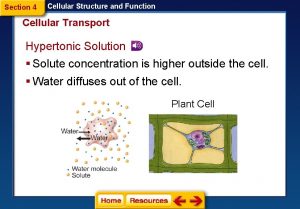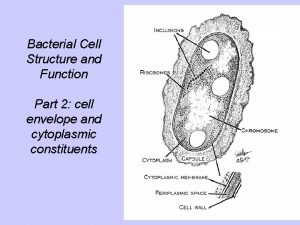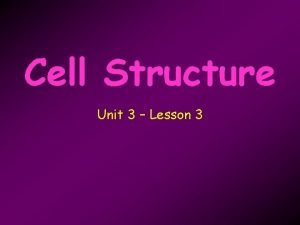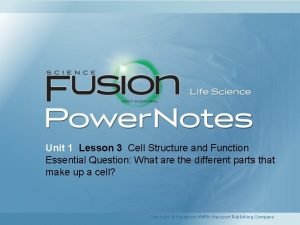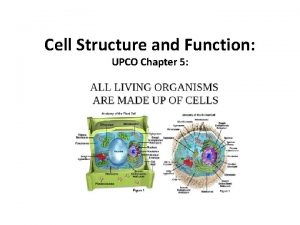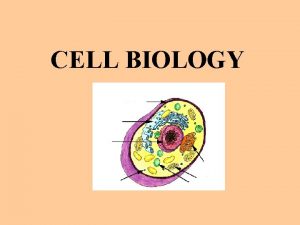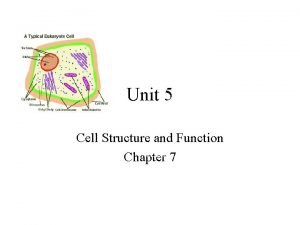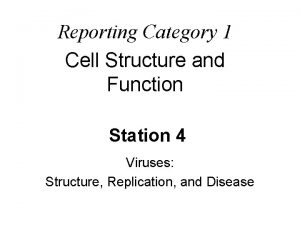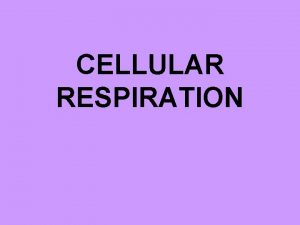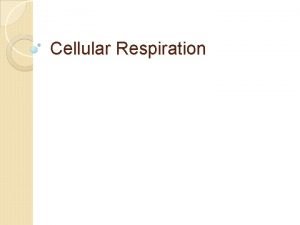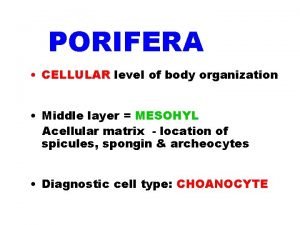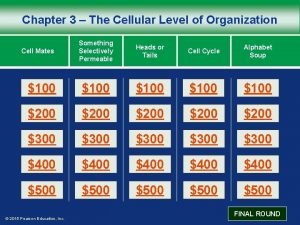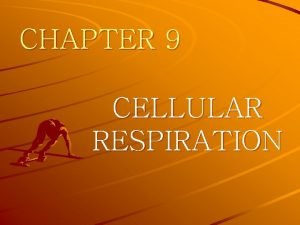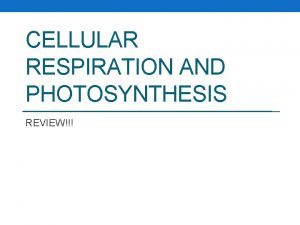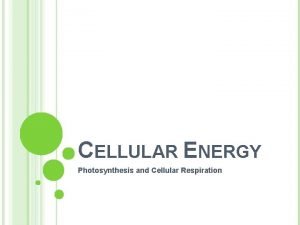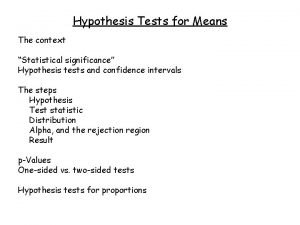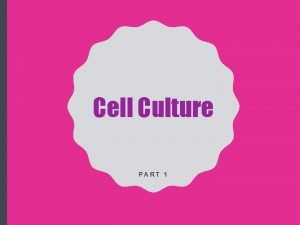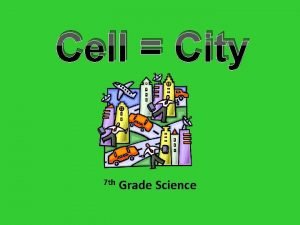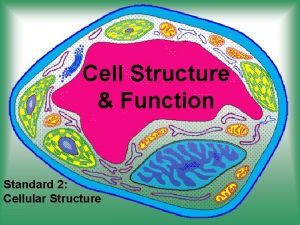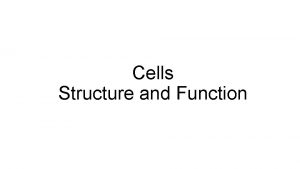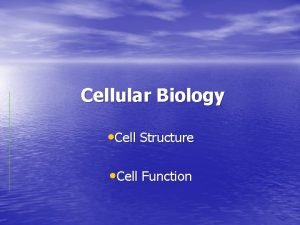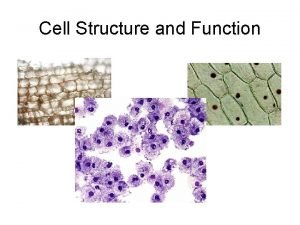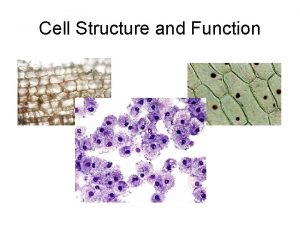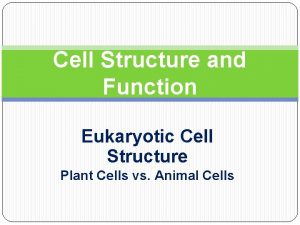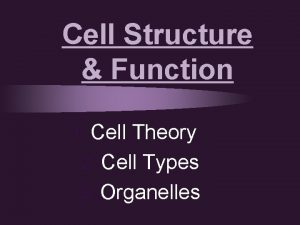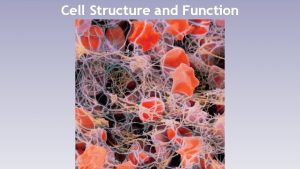Cell Structure and Function 2 1 Cellular Level






















































- Slides: 54


Cell Structure and Function � 2. 1 Cellular Level of Organization � 2. 2 Prokaryotic Cells � 2. 3 Introducing Eukaryotic Cells � 2. 4 The Nucleus and Ribosomes � 2. 5 The Endomembrane System � 2. 6 Other Vesicles and Vacuoles � 2. 7 The Energy-Related Organelles � 2. 8 The Cytoskeleton

2. 1 Cellular Level of Organization • The cell theory is based upon the work of Schleiden, Schwann, and Virchow. It states that: – All organisms are composed of cells – Cells are the basic units of structure and function in organisms – Cells come only from preexisting cells because cells are self reproducing.


Cell Size

2. 2 Prokaryotic Cells

Two different types of cells exist • Prokaryotic are so named because they lack a membrane bounded nucleus. They are divided into two types, based on DNA and RNA base sequence differences. – Bacteria – Archaea • Eukaryotic cell which has a nucleus. • Animal cells, plant cells and those of fungi and many protists.

The Structure of Prokaryotes

• A rod shaped bacterium is called a bacillus • Spherical shaped bacterium is a coccus. • Some long rods are twisted into spirals, in which case they are spirilla if they are rigid or spirochetes if they are flexible.

The DNA of a prokaryote is found in a chromosome that coils up and is located in a region called the nucleoid. Many bacteria also have an extrachromosomal piece of circular DNA called a plasmid. Plasmids are used in biotechnology laboratories. This technology is important in the production of new medicines.

2. 3 Introducing Eukaryotic Cells

Structure of Eukaryotic Cell Eukaryotic cells have compartments called organelles. Each membranous organelle has a specific structure and function.



2. 4 The Nucleus and Ribosomes

The Nucleus The chromosomes are the carriers of genetic information and that the nucleus is the command center of the cell.


• Some cells, such as skeletal muscle cells, can have more than one nucleus. • The nucleus contains chromatin in the nucleoplasm. Chromatin condenses into chromosomes. All the cells of an individual contain the same number of chromosomes, but the egg and sperm, have half this number. • Chromatin, and therefore chromosomes, contains DNA, protein, and some RNA (ribonucleic acid). Genes, composed of DNA, are units of heredity located on the chromosomes.

• Three types of RNA are produced in the nucleus: ribosomal RNA (r. RNA), messenger RNA (m. RNA), and transfer RNA (t. RNA). Ribosomal RNA is produced in the nucleolus, a dark region of chromatin where r. RNA joins with proteins to form the subunits of ribosomes. • The nucleus is separated from the cytoplasm by a double membrane known as the nuclear envelope. The nuclear envelope has nuclear pores.

The Ribosomes They are particles where protein synthesis occurs.

• They are composed of two subunits, one large and one small. Each subunit has its own mix of proteins and r. RNA. • The number of ribosomes in a cell varies depending on its functions. For example, pancreatic cells and those of other glands have many ribosomes because they produce secretions that contain proteins. • In eukaryotic cells, some ribosomes occur freely within the cytoplasm, either singly or in groups called polyribosomes, and others are attached to the endoplasmic reticulum (ER).


2. 5 The Endomembrane System • The endomembrane system consists of: – The nuclear envelope – The membranes of the endoplasmic reticulum – The Golgi apparatus – Several types of vesicles.


The endoplasmic reticulum

• The endoplasmic reticulum (ER) consisting of a membranous channels and saccules (flattened vesicles), which is continuous with the nuclear envelope. • The ER consists of rough ER and smooth ER. • Both rough and smooth ER form vesicles that transport molecules to other parts of the cell.

• Rough ER is studded with ribosomes on the side of the membrane that faces the cytoplasm, and because of this, rough ER has the capacity to produce proteins. • Inside its lumen, rough ER contains enzymes that can add carbohydrate (sugar) chains to proteins, and then these proteins are called glycoproteins.

• Smooth ER does not have attached ribosomes. • Certain organs contain an abundance of smooth ER and its function depends on the organ. In some organs, smooth ER is associated with the production of lipids. For example, in the testes, smooth ER produces testosterone, a steroid hormone. • In the liver, smooth ER helps detoxify drugs.

The Golgi apparatus is named for Camillo Golgi, who discovered its presence in cells in 1898.

The Golgi Apparatus • The Golgi apparatus consists of a stack slightly curved, flattened saccules. Vesicles can be seen at the edges of the saccules. • Protein filled vesicles that bud from the rough ER and lipid filled vesicles that bud from the smooth ER are received by the Golgi apparatus. It can change one sugar for another sugar. • The Golgi apparatus sorts the modified molecules and packages them into vesicles that depart from the outer face. In animal cells, some of these vesicles are lysosomes.

Lysosomes • They are membrane bounded vesicles produced by the Golgi apparatus. • They have a very low p. H and store powerful hydrolytic digestive enzymes in an inactive state.

Lysosomes • Lysosomes assist in digesting material taken into the cell • They destroy nonfunctional organelles. • Some white blood cells defend the body by engulfing bacteria that are then enclosed within vacuoles. When lysosomes fuse with these vacuoles, the bacteria are digested.

2. 6 Other Vesicles and Vacuoles

Peroxisomes • Peroxisomes, similar to lysosomes, are membrane bounded vesicles that enclose enzymes. • However, the enzymes in peroxisomes are synthesized by free ribosomes and transported into a peroxisome from the cytoplasm.

Peroxisomes • All peroxisomes contain enzymes whose actions result in hydrogen peroxide (H 2 O 2). • They are synthesizing and breaking down lipids. • In the liver, some peroxisomes produce bile salts from cholesterol, and others break down fats.

Peroxisomes • Plant cells germinating seeds, they oxidize fatty acids into molecules that can be converted to sugars needed by the growing plant. In leaves, peroxisomes can carry out a reaction that is uses up oxygen and releases carbon dioxide.

Vacuoles

• Vacuoles are membranous sacs, but vacuoles are larger than vesicles. • The contractile vacuoles of some cells get rid of excess water others digestive vacuoles for breaking down nutrients. • Few animal cells contain vacuoles.

Plant vacuoles contain water, sugars, salts, pigments and toxic molecules. The pigments are responsible for many of the red, blue, or purple colors of flowers and some leaves.

The toxic substances help protect a land plant from herbivorous animals.

Plant Cell Central Vacuole

• Typically, plant cells have a large central vacuole that may take up to 90% of the volume of the cell. • The central vacuole function is: – Storage of both nutrients and waste products. – It is filled with a watery fluid called cell sap that support the cell. – It maintains hydrostatic pressure in plant cells. – As organelles age and become nonfunctional, they fuse with the vacuole, where digestive enzymes break them down.

Plant Cell Central Vacuole

2. 7 The Energy Related Organelles

Chloroplasts


• Chloroplasts have a three membrane system. They are bounded by a double membrane. • The double membrane encloses: – The semifluid stroma, which contains enzymes and thylakoids, – Disk like sacs formed from a third chloroplast membrane. – A stack of thylakoids is a granum.

• Chlorophyll and the other pigments that capture solar energy are located in the thylakoid membrane, and the enzymes that synthesize carbohydrates are located outside thylakoid in the fluid of the stroma.

Other Types of Plastids • Chromoplasts contain pigments that result in a yellow, orange, or red color. Chromoplasts are responsible for the color of autumn leaves, fruits, carrots, and some flowers. • Leucoplasts are generally colorless plastids that synthesize and store starches and oils. A microscopic examination of potato tissue yields a number of leucoplasts.

Mitochondria

• Nearly all eukaryotic cells, and certainly all plant and algal cells in addition to animal cells, contain mitochondria. • The number of mitochondria can vary in cells depending on their activities. Some cells, such as liver cells, may have as many as 1, 000 mitochondria.

• Mitochondria have two membranes, the outer membrane and the inner membrane. • The inner membrane is highly convoluted into cristae that project into the matrix. These cristae increase the surface area of the inner membrane so much that in a liver cell they account for about one third the total membrane in the cell. • The inner membrane encloses a semifluid matrix, which contains mitochondrial DNA and ribosomes.

• Mitochondria are often called the powerhouses of the cell because they produce most of the ATP utilized by the cell. The entire process, which also involves the cytoplasm, is called cellular respiration because oxygen is used and carbon dioxide is given off, as shown on the previous page.

 Molecular level vs cellular level
Molecular level vs cellular level Chapter 7 section 4 cellular transport
Chapter 7 section 4 cellular transport Cellular transport and the cell cycle
Cellular transport and the cell cycle What is the function of a cell
What is the function of a cell Bacterial cell structure and function
Bacterial cell structure and function Lesson 3 cell structure and function answer key
Lesson 3 cell structure and function answer key Cell structure graphic organizer
Cell structure graphic organizer What is the purpose of the cell membrane in a plant cell
What is the purpose of the cell membrane in a plant cell Lesson 3 cell structure and function answer key
Lesson 3 cell structure and function answer key Biology chapter 7 cell structure and function
Biology chapter 7 cell structure and function Chapter 7 cell structure and function section review 7-2
Chapter 7 cell structure and function section review 7-2 Cell organelles graphic organizer
Cell organelles graphic organizer Chapter 5 cell structure and function
Chapter 5 cell structure and function Plastids in plant cell
Plastids in plant cell Unit 5 cell structure and function answer key
Unit 5 cell structure and function answer key Category 1 cell structure and function
Category 1 cell structure and function Category 1 cell structure and function
Category 1 cell structure and function Category 1: cell structure and function
Category 1: cell structure and function All cells must contain
All cells must contain Where in the cell does cellular respiration occur
Where in the cell does cellular respiration occur Where in the cell does cellular respiration occur
Where in the cell does cellular respiration occur Porifera body organization
Porifera body organization Chapter 3 the cellular level of organization
Chapter 3 the cellular level of organization What are the reactants and products of photosynthesis?
What are the reactants and products of photosynthesis? Function of cellular respiration
Function of cellular respiration Cellular respiration equation
Cellular respiration equation Advantages and disadvantages of diaphragm cell process
Advantages and disadvantages of diaphragm cell process Linear chromosomes in eukaryotes
Linear chromosomes in eukaryotes Venn diagram of plant and animal cells
Venn diagram of plant and animal cells Plant cell and animal cell diagram
Plant cell and animal cell diagram Types of secondary cells
Types of secondary cells Differences between plant animal and bacterial cells
Differences between plant animal and bacterial cells Cell cycle and cell division
Cell cycle and cell division Life
Life The scientist mathias schleiden studied _______ in ______.
The scientist mathias schleiden studied _______ in ______. Idealized plant cell
Idealized plant cell Walker cell and hadley cell
Walker cell and hadley cell Cell cycle and cell division
Cell cycle and cell division Plant animal cell venn diagram
Plant animal cell venn diagram Cell cycle chart
Cell cycle chart Galvanic vs electrolytic cell
Galvanic vs electrolytic cell Flexible covering of an animal cell
Flexible covering of an animal cell Dr shaffi
Dr shaffi Significance level and confidence level
Significance level and confidence level Confidence level and significance level
Confidence level and significance level Data flow diagram for employee management system
Data flow diagram for employee management system Cell city analogy
Cell city analogy Prokaryotic vs eukaryotic cell
Prokaryotic vs eukaryotic cell Lithium ion battery reaction equation
Lithium ion battery reaction equation Dry cell vs wet cell
Dry cell vs wet cell Cell wall vs cell membrane
Cell wall vs cell membrane 10 cm dish surface area
10 cm dish surface area Finite and continuous cell lines
Finite and continuous cell lines Cell city introduction
Cell city introduction Cell-cell junction
Cell-cell junction

